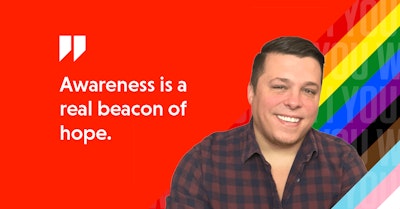
Talking privilege is a blog series for MiQ employees to discuss different kinds of privilege and the ways they affect work and life in general. Privilege can be a hard topic to discuss. Many people who benefit from privilege on a daily basis aren’t aware their privilege exists. And people with less of the unearned power that privilege affords often have less power within their business too.
We started this blog series to reflect on the different types of privilege we all need to be aware of in MiQ, in our industry, and in society at large.
By Manar Abbas, Client Services Associate, MiQ
There’s this social phenomenon of being the daughter of Palestinian immigrants in a dominantly white society where I’ve never fully fit in either world. Similarly, I’m a female in an industry perpetually known for its male dominance. These phenomena are the source of my constant pursuit of a sense of belonging, and simultaneously the source of my resilience.
To mitigate this, I find myself protecting against bias by overcompensating with ample amounts of empathy. Why? Empathy leads to connection on a human level. It is the loophole that allows me to build a relationship with someone without having commonalities in our gender or race. But even that is a privilege I carry; the ability to speak, to be proficient in a common language.
This overlap in identities – gender and race – will be our backdrop for understanding intersectionality.
What is Intersectionality?
Think of it as ‘layers’ – intersectionality asserts that people’s layered identities are a source of disadvantage. For example, a woman of color with a physical disability, or a transgendered black man. The concept is often in the shadow of a far more familiar term – privilege. That’s because, individuals with more ‘layers’ or more identities carry less privilege (identities include gender identity, race, sexual orientation, socio-economic status, ability, etc.). Privilege is an unfair advantage, or a right available only to a certain group of people.
(Bonus: Kimberlé Crenshaw coined the term to evaluate where black women fit within the feminist movement.)
This warrants an introduction.
Let me preface with a bit of context – my family and I arrived in Toronto as refugees, when 8-year old Manar had little insight into the long-term impact of being raised in a culture where I’m seen as a minority. We were visibly new, excited at the sight of the first snowfall, and within three weeks of our arrival – our house was egged, and a week later our mail burned (don’t worry – happy ending to follow). Resilience meant cleaning up and moving on. In retrospect, we neglected the importance of mindfully processing the incidents, but admittedly, that would have been a luxury – we had critical tasks to prioritize: schools, jobs, our pending immigration status. This is the ethos of the underprivileged, “get it together – and fast – or you’ll fall behind”.
The silver lining? A lovely neighbor named Eva – the heaven-sent ally and advocate that would drive my mom to buy groceries, carpool me to school with her granddaughter, and guide our first Halloween and Thanksgiving experiences (I couldn’t believe free candy was this easy!). She was a middle-class white woman who used her privilege to empower us – she introduced us to our tenant rights and Canadian culture – needless to say, I feel forever indebted to her. Consider offering advocacy to someone who may need an Eva, particularly if you carry privilege.
What are the implications of Intersectionality at work?
A 2018 Harvard Business Review article found that women of color often get tasked with ‘housework’ (the administrative end of a job description) over ‘glamour work’ (the exciting projects that put you on the map and get you promoted). You can imagine how this further imposes an unfair advantage for an individual who identifies as LGTBTQ+, or who may have a physical disability where barriers take architectural, physical form.
As I navigated through school and into my career, there’s been a consistent rhythm of abrupt reminders that I’m seen as an individual of a gender and racial minority. Whether it was the promotion of a white female colleague (by a white male manager) despite demonstrating a lackadaisical demeanor, or being excluded from a Christmas gift exchange under the assumption that I wouldn’t like to celebrate (always ask, never assume). In incidents like this – and here comes the silver lining again – you uncover your advocates, your supporters. These are the people who use their voice and impact to stand up for you and elevate you.
Being among the first in a space generally means braving the highest resistance. Consequently, it can be exhausting navigating spaces where I’m not represented. The reality is – advocacy around female leadership mainly prioritizes white women. And while it is absolutely a step in the right direction, I’ve inevitably had to reconcile that representation of women of color will not be mirrored in leadership roles, for now.
At the same time, I love that my story can serve as a point of learning for the person across the table: sharing culture, debunking stereotypes, sharing food! I’ve come to value the added depth and perspective that enables me to toggle between two vastly different cultures. It is the same premise that has unlocked the art of communicating with vastly varied individuals.
Where do you come in?
As a Palestinian-Canadian woman paving a path in a space where few share my experience, I have a couple of guidelines for how to positively embrace intersectionality at work. I encourage you to reach out across communities to continue knowledge-sharing and building a repository of guidelines. The TL;DR here is – your advocacy ripples faster than you think!
1. Create equitable opportunity
Picture this: two individuals, Synth and Chord; Synth has one key, Chord has three keys. An equal approach means I’d give the same amount of keys to each. Because Chord started with more, Chord will end up with more. Whereas, an equitable approach means providing Synth with enough keys to ensure both Synth and Chord end up with the same amount of keys.
Equity helps to bridge this gap so that no one faces added barriers in order to end up at the same finish line. If we think of the keys as symbolizing resources, we can conceptualize how giving those with less privilege the same amount of resources as those with more privilege, means that the latter will always have an advantage. The former will be left to compensate for the deficit in order to seize the same opportunity.
2. Seek diverse points of view
Whether or not you carry more privilege or are in a decision-making role, leverage an opportunity to lead positive change. I encourage you not to shy away from interacting with individuals whose experiences differ from yours. Recognize the implications of ‘difference’ and elevate underrepresented voices. Create an accepting, non-judgmental environment that welcomes vulnerable conversation – grab a coffee, eat lunch with someone new. If you’re more comfortable within the scope of business projects, extend an invitation to a brainstorm meeting, offer up an exciting opportunity that could put someone on the map. The sooner you immerse yourself in this uncomfortable task, the faster you build thoughtful and inclusive relationships. The caveat here is – while you can welcome conversation with open arms, be ready to respect someone’s decision not to reciprocate. Sharing is a personal experience – you can continue to position yourself as an ally by being ready to support and advocate where possible.
Intersectionality broadens the scope in which we understand privilege. Although the hurdles I’ve encountered have haphazardly thrown off my tempo, they often fueled periods of calibration and ultimately uncovered a silver lining. But it’s not always the case, which is why it is imperative that you lead by being a catalyst for positive change. When we recognize the complexities of experiences, and the ways in which identity informs opportunity, we are better equipped to foster a space that is inclusive, diverse, and equitable.
You can read more in the Privilege & Race blog series by following these links:
- Privilege & Race by Kayode Ijaola, Group Trader Manager, MiQ
- Privilege & Gender by Rebecca Rosborough, Chief Marketing Officer, MiQ
- Privilege & Neurodiversity by Clare Martin, Director of Talent, EMEA & APAC, MiQ
- Privilege & Sexual Orientation by Matthew Engstrom, Global Head of Product Marketing, MiQ
- 1.1




